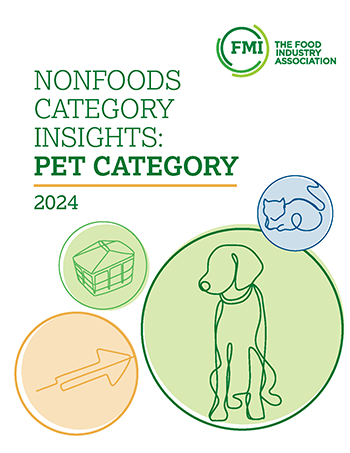
By: Tom Duffy, Senior Advisor, Nonfoods Community Development, FMI
When it comes to purchasing pet food, where do most people go? The local grocery store. It's a convenient one-stop shop for all our household needs, including the essential sustenance for our beloved pets. The latest Category Insights report from FMI highlights how grocery stores are uniquely positioned to capture sales in the continually growing pet food category.
Convenience and Accessibility
Grocery stores are ideal for pet food sales due to the sheer convenience they offer. Pet owners often juggle busy schedules and the ability to pick up their pet's food along with the week's groceries is a huge time-saver. FMI's Category Insights emphasizes how this convenience factor drives a significant portion of pet food sales in grocery stores.
Cross-Merchandising Opportunities
The report highlights the opportunity for cross-merchandising. Grocery stores can strategically place pet food alongside related products, such as pet toys, treats and accessories. This strategy makes it convenient for shoppers to pick up a bag of dog food and grab a new chew toy or a bag of treats displayed nearby.
Grocery stores – especially those that are beginning to embrace the ability to be omnichannel – are ideally positioned to capture sales in the pet food category as they meet their shoppers where they are. We are pleased to see healthy trading partner relationships in all areas and store sizes that point to continued success in this approach.
Expanding Assortments
Grocery stores are increasingly expanding assortments of pet food to cater to the diverse needs of pet owners. As outlined in the report, the trend is towards more specialized diets backed by science and life stage-specific formulas. By offering a wide range of options, grocery stores can attract a broader customer base, from those seeking basic, economical options to those looking for super premium, specialized products.
Evolving Consumer Preferences
Category Insights delves into evolving consumer preferences, showing that pet owners are looking for high-quality ingredients, nutritional benefits and trusted brands. Grocery stores, with their ability to carry well-known brands like Purina, are perfectly positioned to meet these demands.

The Rise of E-Commerce Integration
Brick-and-mortar stores are crucial, but the FMI report also highlights the integration of e-commerce in pet food retail. Grocery stores now provide online ordering and delivery, combining traditional shopping with modern convenience for pet owners to access preferred brands easily.
Grocery stores offer convenience and cross-merchandising, meeting evolving pet owner preferences. As pet health remains a priority, grocery stores adapt to ensure seamless and enjoyable pet food shopping experiences.

 Industry Topics address your specific area of expertise with resources, reports, events and more.
Industry Topics address your specific area of expertise with resources, reports, events and more.
 Our Research covers consumer behavior and retail operation benchmarks so you can make informed business decisions.
Our Research covers consumer behavior and retail operation benchmarks so you can make informed business decisions.
 Events and Education including online and in-person help you advance your food retail career.
Events and Education including online and in-person help you advance your food retail career.
 Food Safety training, resources and guidance that help you create a company food safety culture.
Food Safety training, resources and guidance that help you create a company food safety culture.
 Government Affairs work — federal and state — on the latest food industry policy, regulatory and legislative issues.
Government Affairs work — federal and state — on the latest food industry policy, regulatory and legislative issues.
 Get Involved. From industry awards to newsletters and committees, these resources help you take advantage of your membership.
Get Involved. From industry awards to newsletters and committees, these resources help you take advantage of your membership.
 Best practices, guidance documents, infographics, signage and more for the food industry on the COVID-19 pandemic.
Best practices, guidance documents, infographics, signage and more for the food industry on the COVID-19 pandemic.
